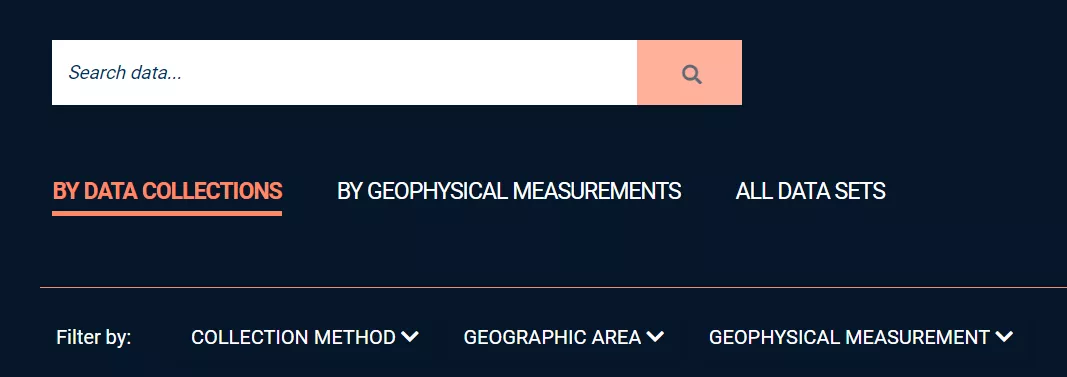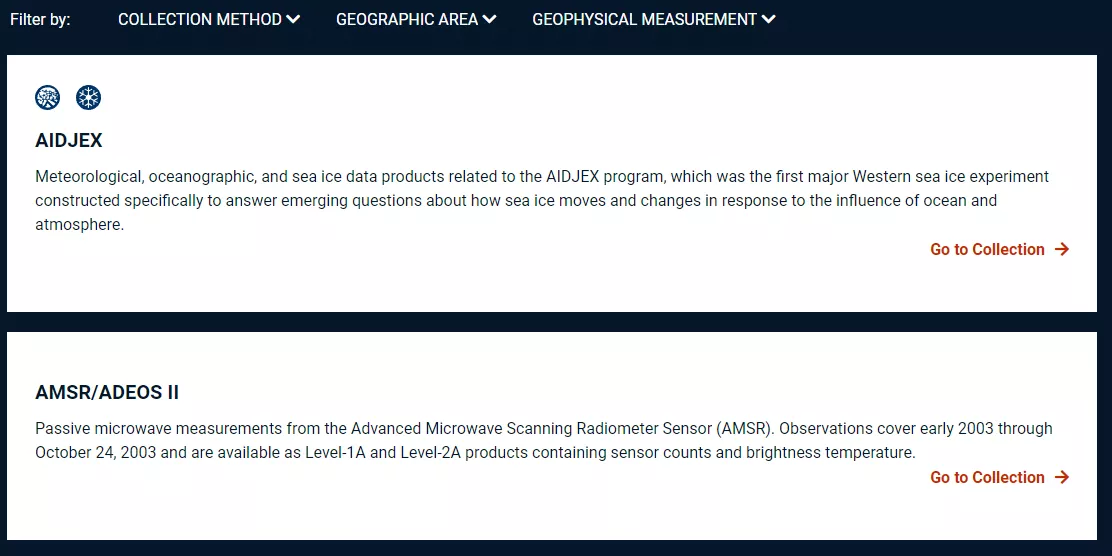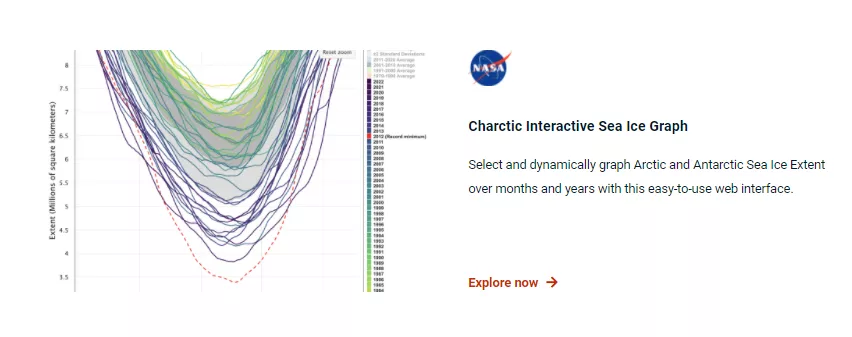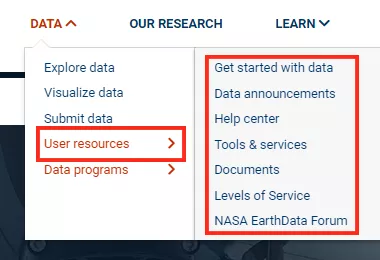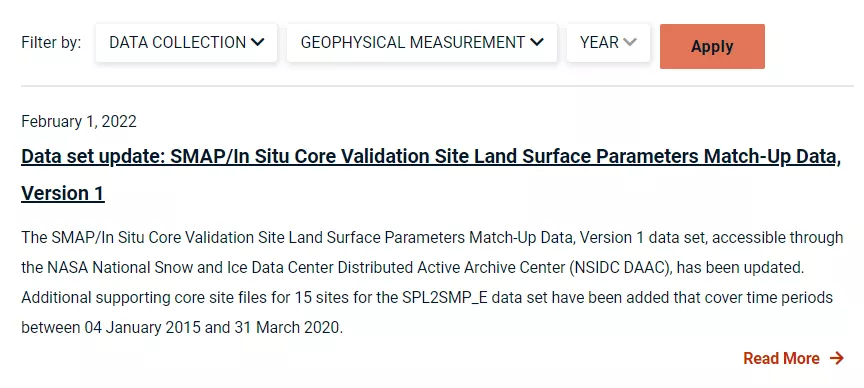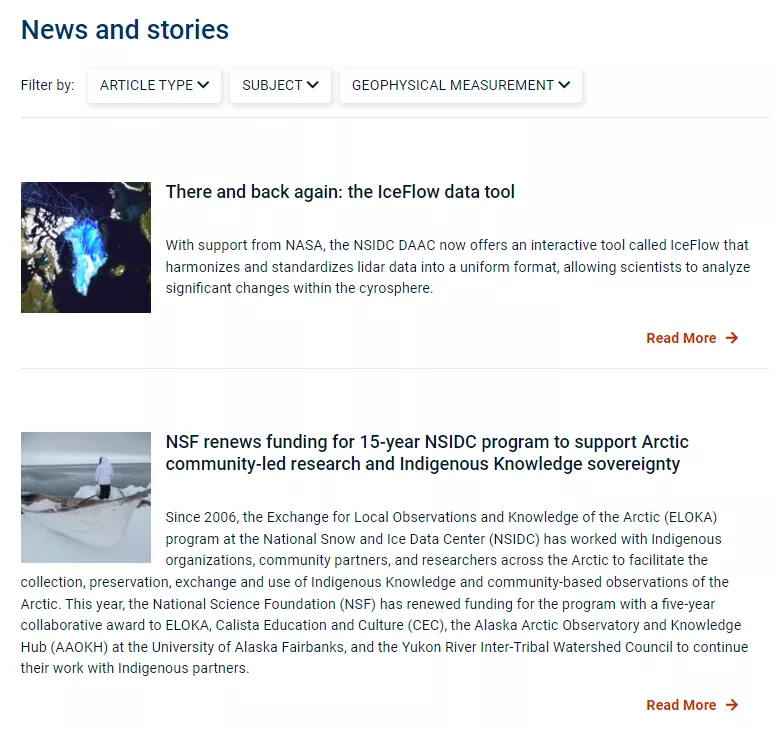Welcome to the latest and greatest version of NSIDC.org! Our website now offers an even more intuitive and efficient interface to allow users from all different backgrounds to discover and analyze over 1,400 data sets and gain expert-verified knowledge about the cryosphere. If you have visited NSIDC.org frequently in the past, the appearance of our new site may be a bit confusing at first. However, we hope we have made it even easier to find the same resources you are used to…plus a few extra features.
Overall, the site is responsive and more mobile friendly. Some of our older interactive applications are still best viewed on a laptop or desktop computer. We have also improved accessibility throughout the site wherever possible. In terms of content, we’ve maintained the majority of what existed on our old site, but with a more clearly defined organization. So, if you have typically typed in a search term to go directly to a page in the past, we encourage you to use the main navigation of the site to explore and discover resources you may not have found before!
Read on for more detail on our new site organization and what has changed.
Intro to our homepage
Our new homepage features quick and easy access buttons to both our data and our research. Below that is our new and improved geophysical measurements section. Click on each icon to expand the section and discover related data, data collections, research projects, and even educational content.
The homepage also provides easy access to various types of news stories, updates, and analyses, so be sure to scroll down and check out all the resources we are currently featuring.
Multiple ways to explore data
Once you click the Explore Data button on the homepage, you will see multiple ways to explore and discover NSIDC data. This page allows you to:
- Easily search the NSIDC data catalog by keywords
- Explore by data collection
- Narrow down your data search by geographical measurement
- Get directly to the data catalog via the "All Data Sets" link
On the data collections list, you will notice some new filter options that allow you to filter by collection method, geographic area, and geophysical measurement.
Easier-to-find data collections
Looking for information about the NASA mission data and other projects we manage? Feeling overwhelmed by the quantity of data we host? As mentioned above, the Explore Data page includes a list of data collections which are organized into a standardized format and represent different data management projects we manage for NASA and NOAA.
Collections pages provide a quick and easy way to understand the types of data in each collection and determine if they are of interest to you. Within each data collection, you will find a sidebar menu to view an overview of the data, plus documentation, help articles, a list of published research using data from the collection, data announcements, a list of collection data and other resources to better understand each collection. Make sure to also check out the full data catalog as well which includes many more data products and facets to help you narrow down your data search.
A new visualize data page
Previously called Data for Everyone, this new page features interactive data graphics using NSIDC data, which are popular among users from all backgrounds. Visit this page to see if we have launched any new easy-to-use interactive data visualizations.
Enhanced data set landing pages
Data set landing pages have a new look and feel with all the same content plus more. First, the new scrolling layout is mobile-friendly and responsive. At the top of each data set landing page, there is a set of icons to allow you to easily access the data set user guide, copy and paste the data set citation, subscribe for new data updates, and quickly determine the level of service NSIDC offers for each data set. As you scroll down the page, you will see a new Data Access & Tools section which lists all the ways you can access the data as well as tools to work with the data. Related technical documentation, and help articles are listed further down the page.
Data user resources
In addition to easily accessing user resources like help articles and documents directly on data set landing pages and data collections, we’ve also created a user resources section, under the Data menu. This section includes a new Getting started with data page, which is a good first stop if you are new to accessing and using data at NSIDC.
Under User Resources, you’ll also find a listing of all our data tools and services, help center articles, data announcements, documents, and an explanation of how NSIDC provides Levels of Service for the data we manage. Please note that our new Help Center was previously called "Knowledge Base."
As always, our friendly and knowledgeable User Services team is standing by and ready to respond to any questions you have. On our website, you can easily send an inquiry to our User Services team by clicking the Support button in the bottom right corner of any webpage. We aim to respond to your question or comment as quickly as possible, in most cases within one (1) business day of receiving it.
Updates to Data announcements
“The Drift,” where data announcements were previously published, has been retired, so please update your bookmarks. Data announcements are now aggregated on the Data Announcements page, under DATA > User resources, where you can filter by data collection, geophysical measurement, and/or the year the announcement was made. You can also find these announcements on data collection pages as well the NASA NSIDC DAAC program page and the NOAA@NSIDC program page.
Learn about the cryosphere
NSIDC.org has long been a trusted resource on the cryosphere for educators, the media and the general public, but we believed this information could be better organized and presented on our new site. Our Learn section carried over much of the content from our former “About the Cryosphere” and “State of the Cryosphere” section while ensuring everything was updated and verified by our in-house scientific experts. You’ll now find a section called “What is the cryosphere,” along with seven sections summarizing the major features of the cryosphere. Each section has a consistent format that includes an Overview of the feature, the Science behind it, Why It Matters, and Quick Facts.
We have also compiled a list of “Ask a Scientist” type articles, which includes common questions about the cryosphere. We will continue to add articles as we receive popular inquiries from our users.
News and Analyses
As the preeminent expert in the cryosphere, NSIDC is frequently mentioned in the news, and we’ve published many stories and scientific analyses ourselves, but for some users, these pieces could be difficult to find on our previous website.
Our News and Analyses section now offers quick access to some of our most popular informational pages, including:
The News and stories section also includes several different types of articles, including longer feature stories, shorter spotlights, and news releases. These articles will not only be available on the News and stories section, but are also tagged to show the most relevant articles at various other locations across the website.
We also have a new Multimedia page that provides quick access to NSIDC image albums and videos.
Get to know Our Research
Our previous Research section on the website included some information on our scientists and expeditions we have undertaken, but didn’t show the full scope of everything NSIDC researchers were involved in. The Our Research section now includes a more thorough overview of our research efforts, updated profiles of our scientists, and news stories and research that involve NSIDC scientists. One of the most significant additions is a Featured Research Projects page, which shows NSIDC’s major active research collaborations.
About NSIDC
For those who want to learn more about the history of NSIDC, how we operate, and the people behind the data, you will find it in our About NSIDC section where you can read up on what we do, our people, and our history.
Looking to join the NSDIC team? Our Careers page lists current opportunities, and more on why NSIDC can be a rewarding place to work.
The For the media page provides information for journalists and broadcasters including how to ask NSIDC staff questions or schedule an interview, and a summary of our media coverage over the years.
Data and citation policies
The vast majority of NSDC data is free and open access, and we maintain certain policies on how we manage that data, and what we require when that data is used. On our Data policies page, you can find our more details on our approach to data stewardship. On our Citation policies page, you can receive more information on how to use and cite data sets, photographs, imagery, and text from the website. To make it easy, we also include easy to copy citations on all our data set landing pages.
Let us know what you think
We plan to continually update and improve our website in the years to come, and value any and all feedback from our users. Have an idea for a website feature that would be helpful to you as a researcher, educator, journalist, or just as a curious member of the general public? Have you got questions or concerns about the website or how to navigate it? Send us your thoughts at nsidc@nsidc.org or by clicking the “Support” button anywhere on our website.



